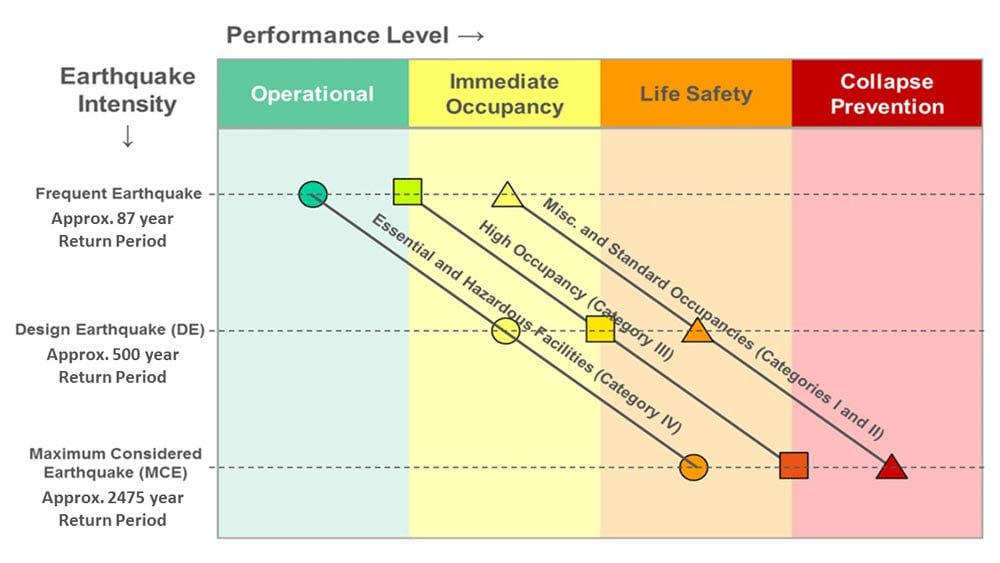
Earlier this year The New York Times published three articles regarding the seismic hazard and safety concerns for tall buildings, particularly those in San Francisco. These articles stimulated discussion both in the public domain and in the engineering community, and they have successfully raised awareness of seismic safety and building design objectives.
Some structural engineers, however, have questioned the veracity of the collapse probabilities discussed in these articles; their questions arose because building safety should be viewed objectively in light of relative seismic performance and judged based on rational scientific criteria. This blog will provide some clarification from AIR engineers on three statements made in the first of these articles (San Francisco’s Big Seismic Gamble), which discussed the unexpected sinking and tilting of the award-winning 58-story Millennium Tower and questioned the safety of the city’s entire high-rise building stock.
“A five-story building has the same strength requirements as a 50-story building”
While the statement above may be surprising, several subtleties surrounding this statement must also be acknowledged:
- More current building codes are based on satisfying mandated performance objectives rather than strength requirements alone.
- With regard to structural engineering and building design, the term “strength” can be interpreted many different ways.
- A building’s vulnerability to damage and potential for collapse is based on more than its strength alone.
All buildings, regardless of height, are designed to satisfy the same set of performance objective criteria. These criteria mandate that a building must exhibit certain behavior under different earthquake intensities. Under very infrequent but severe shaking, the building must be designed to resist collapse for the Maximum Considered Earthquake (MCE). When subjected to a more frequent Design Earthquake (DE) the building must be able to provide life safety by limiting localized collapse of both structural and nonstructural components. Finally, under Frequent Earthquakes (FE) all buildings must also be immediately occupiable. An illustration of how these performance objectives vary with different earthquake intensities can be seen in Figure 1 .

From this table it can also be seen that buildings of more prominent and essential occupancy types are held to more stringent performance objectives for a given earthquake intensity. For example, California has stricter building requirements for schools and hospitals as compared to buildings with more ordinary uses. Furthermore, in addition to these more stringent design requirements there are also mandatory retrofit ordinances dating back to the 1933 Riley Act and the 1973 Alquist Seismic Safety Act that have required the strengthening of buildings deemed to be insufficiently designed to resist earthquakes.
The analysis and design process used to satisfy these performance objectives for five-story and 50-story buildings are typically different and are based on more than strength alone. In addition, the codes also enforce limits on building deformations and require more ductility and stringent detailing for tall buildings. While a simplified (and often conservative) Equivalent Static Force analysis may be permitted for a five-story building, the codes do not permit such a simplified analysis for tall buildings. Due to the uniqueness and prominence of skyscrapers, their design is required to go through a more rigorous dynamic analysis procedure and a peer review. Since 2010 the Pacific Earthquake Engineering Research Center’s Tall Buildings Initiative (TBI) guidelines have provided practical guidance for those responsible for the design of tall buildings.
Ultimately, both building types are required to resist the earthquake forces corresponding to the same hazard level. However, through the differing design approaches for mid-rise and high-rise buildings, the values of the required design forces can be different while still satisfying the same performance objectives for a given level of shaking. Collectively, these measures result in tall buildings that must be more thoroughly analyzed and designed than more ordinary low-rise construction. Damage observations from past earthquakes illustrate the relatively good performance of high-rise structures: no severe damage or collapse was reported for buildings taller than 25 stories in the 1994 Northridge, 1995 Kobe, or even the 1985 Mexico earthquake, which generated strong long period seismic waves in Mexico City.
“How Safe are San Francisco’s skyscrapers?”
There is no short answer to this general question. Given the hazard and code evolution over time, skyscrapers designed in different eras would perform differently in a given event. In general, engineers have confidence in the safety of high-rise buildings that have been designed following the TBI guidelines first published in 2010 when subjected to MCE shaking. However, it is has recently become known that the cladding of skyscrapers (both old and new) might not perform as designed and could fall during an MCE earthquake.
For older skyscrapers, safety is a concern. Some researchers believe that the probability of their collapse is about 10 times that of new skyscrapers when subjected to the current MCE. However, given the uniqueness of each skyscraper and the differences with which they may have been designed and constructed, their safety must be evaluated on a case-by-case basis.
“Right now the code says a structure must be engineered to have a 90 percent chance of avoiding total collapse”
It is true that the current building code is set to achieve no more than 10% probability of collapse when subjected to the MCE hazard level. Although skyscrapers designed following TBI are believed to have a much higher margin of safety against collapse, some experts nevertheless are advocating a shift in the aforementioned design objectives to explicitly consider the potential for damage and to minimize repair costs under the MCE, in addition to ensuring collapse prevention.
The article quotes Dr. Lucy Jones, the former leader of natural hazards research at the United States Geological Survey, as saying “ten percent of buildings will collapse.” According to Dr. Jones during a talk she gave at AIR, she was referring to a scenario study that 10% of all building stocks, including soft-story, unreinforced masonry, and non-ductile reinforced concrete structures, would likely collapse. During a large earthquake such as the one described in the HayWired scenario, about 15% of the affected building stock would experience ground shaking exceeding the MCE hazard level. Since the majority of exposure is shaken below the MCE, the overall collapse in such a situation might not be that high.
In our next blog, we will discuss AIR engineers’ responses to statements made in the other two articles.



